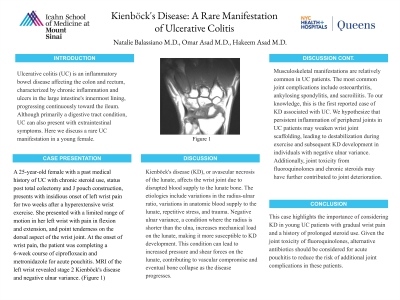Tuesday Poster Session
Category: IBD
P4426 - Kienböck's Disease: A Rare Manifestation of Ulcerative Colitis
Tuesday, October 29, 2024
10:30 AM - 4:00 PM ET
Location: Exhibit Hall E

Has Audio

Natalie Balassiano, MD
NYU Queens Hospital
Queens, NY
Presenting Author(s)
Natalie Balassiano, MD1, Omar Asad, MD2, Hakeem Asad, MD3
1NYU Queens Hospital, Queens, NY; 2University of Miami Miller School of Medicine at JFK Medical Center, Lantana, FL; 3Mayo Clinic College of Medicine and Science, Doral, FL
Introduction: Ulcerative colitis (UC) is an inflammatory bowel disease affecting the colon and rectum, characterized by chronic inflammation and ulcers in the large intestine's innermost lining, progressing continuously toward the ileum. Although primarily a digestive tract condition, UC can also present with extraintestinal symptoms. Here we discuss a rare UC manifestation in a young female.
Case Description/Methods: A 25-year-old female with a history of UC, total colectomy, J pouch construction, and chronic steroid use presented with two weeks of insidious left wrist pain following a hyperextensive wrist exercise. She exhibited limited wrist motion, pain with flexion and extension, and point tenderness on the wrist's dorsal aspect. At the onset of wrist pain, she was completing a 6-week course of ciprofloxacin and metronidazole for acute pouchitis. MRI of the left wrist revealed avascular necrosis of the lunate and negative ulnar variance.
Discussion: Kienböck's disease (KD), or avascular necrosis of the lunate, affects the wrist joint due to disrupted blood supply to the lunate bone. The etiologies include variations in the radius-ulnar ratio, anatomic blood supply variations to the lunate, repetitive stress, and trauma. Negative ulnar variance, a condition where the radius is shorter than the ulna, increases mechanical load on the lunate, making it more susceptible to KD development. This condition can lead to increased pressure and shear forces on the lunate, contributing to vascular compromise and eventual bone collapse as the disease progresses.
Musculoskeletal manifestations are relatively common in UC patients. The most common joint complications include osteoarthritis, ankylosing spondylitis, and sacroilitis. To our knowledge, this is the first reported case of KD associated with UC. We hypothesize that persistent inflammation of peripheral joints in UC patients may weaken wrist joint scaffolding, leading to destabilization during exercise and subsequent KD development in individuals with negative ulnar variance. Additionally, joint toxicity from fluoroquinolones and chronic steroids may have further contributed to joint deterioration.
This case highlights the importance of considering KD in young UC patients with gradual wrist pain and a history of prolonged steroid use. Given the joint toxicity of fluoroquinolones, alternative antibiotics should be considered for acute pouchitis to reduce the risk of additional joint complications in these patients.

Disclosures:
Natalie Balassiano, MD1, Omar Asad, MD2, Hakeem Asad, MD3. P4426 - Kienböck's Disease: A Rare Manifestation of Ulcerative Colitis, ACG 2024 Annual Scientific Meeting Abstracts. Philadelphia, PA: American College of Gastroenterology.
1NYU Queens Hospital, Queens, NY; 2University of Miami Miller School of Medicine at JFK Medical Center, Lantana, FL; 3Mayo Clinic College of Medicine and Science, Doral, FL
Introduction: Ulcerative colitis (UC) is an inflammatory bowel disease affecting the colon and rectum, characterized by chronic inflammation and ulcers in the large intestine's innermost lining, progressing continuously toward the ileum. Although primarily a digestive tract condition, UC can also present with extraintestinal symptoms. Here we discuss a rare UC manifestation in a young female.
Case Description/Methods: A 25-year-old female with a history of UC, total colectomy, J pouch construction, and chronic steroid use presented with two weeks of insidious left wrist pain following a hyperextensive wrist exercise. She exhibited limited wrist motion, pain with flexion and extension, and point tenderness on the wrist's dorsal aspect. At the onset of wrist pain, she was completing a 6-week course of ciprofloxacin and metronidazole for acute pouchitis. MRI of the left wrist revealed avascular necrosis of the lunate and negative ulnar variance.
Discussion: Kienböck's disease (KD), or avascular necrosis of the lunate, affects the wrist joint due to disrupted blood supply to the lunate bone. The etiologies include variations in the radius-ulnar ratio, anatomic blood supply variations to the lunate, repetitive stress, and trauma. Negative ulnar variance, a condition where the radius is shorter than the ulna, increases mechanical load on the lunate, making it more susceptible to KD development. This condition can lead to increased pressure and shear forces on the lunate, contributing to vascular compromise and eventual bone collapse as the disease progresses.
Musculoskeletal manifestations are relatively common in UC patients. The most common joint complications include osteoarthritis, ankylosing spondylitis, and sacroilitis. To our knowledge, this is the first reported case of KD associated with UC. We hypothesize that persistent inflammation of peripheral joints in UC patients may weaken wrist joint scaffolding, leading to destabilization during exercise and subsequent KD development in individuals with negative ulnar variance. Additionally, joint toxicity from fluoroquinolones and chronic steroids may have further contributed to joint deterioration.
This case highlights the importance of considering KD in young UC patients with gradual wrist pain and a history of prolonged steroid use. Given the joint toxicity of fluoroquinolones, alternative antibiotics should be considered for acute pouchitis to reduce the risk of additional joint complications in these patients.

Figure: MRI of the left wrist significant for avascular necrosis of the lunate and negative ulnar variance; Kienböck's Disease Stage 2.
Disclosures:
Natalie Balassiano indicated no relevant financial relationships.
Omar Asad indicated no relevant financial relationships.
Hakeem Asad indicated no relevant financial relationships.
Natalie Balassiano, MD1, Omar Asad, MD2, Hakeem Asad, MD3. P4426 - Kienböck's Disease: A Rare Manifestation of Ulcerative Colitis, ACG 2024 Annual Scientific Meeting Abstracts. Philadelphia, PA: American College of Gastroenterology.
